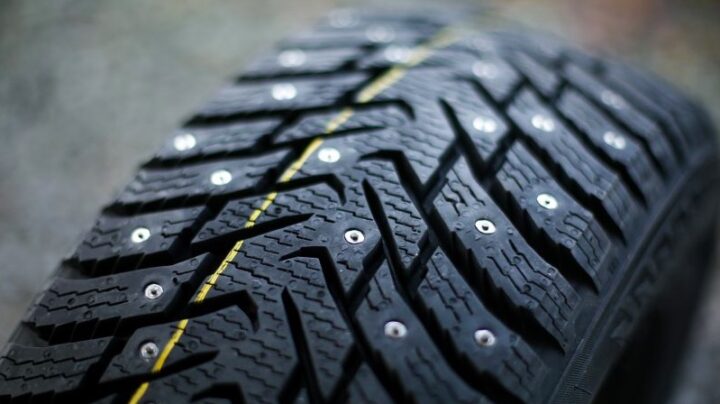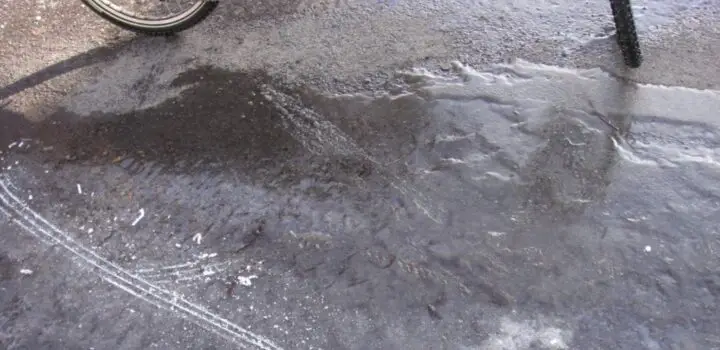Black ice is quite possibly the worst condition you can find while driving. Black ice looks like normal pavement while driving at speed. Usually, you find out there is black ice on the road the wrong way i.e. by a sudden loss of control.
Nobody likes this and it can be very dangerous. There are ways to help driving through black ice safely. To be as safe as you can, NOT driving on ice is the safest. But as we learned in Sex Ed in middle school, abstinence is not the best or most practical answer.

Snow tires help on black ice quite a bit. Snow tires with all-wheel drive (AWD) or 4×4 can be ideal. Sometimes chains are unavoidable and you will need them on top of 4×4 or AWD.
Table of Contents
Do Winter Tires Make A Difference On Ice?
Yes, winter tires make a difference on the ice. Winter tires offer more control in cold weather than summer tires, all-season tires, or all-terrain tires. With that said, you can still slide and lose control driving on ice with winter tires. Ice is ice. It can be very slippery and no rubber tire will give you complete control. Black ice included.
Winter tires make a difference on ice enough where you should use them. Practice safe driving and you should avoid most if not all dangerous occurrences. I recommend carrying chains in winter to cover your butt as well even if your vehicle has AWD or it is a 4×4. Always be prepared like the boy scouts!

What Are The Best Tires For Black Ice?
While there is not a perfect tire to protect against ice, winter tires are the best tires for black ice. Winter tires have softer rubber to grip the elements and larger gaps in the tread to shed snow and ice from the tire. Sharper edges around the tire and siping on the tread face maximize grip in cold weather.
Studded tires are the best option for only icy roads. Tire studs can handle horrible on the pavement with little snow or ice. Studded tires interfere with tire grip between the rubber and the asphalt. They are sort of an all-or-nothing thing.
If you are driving very little on pavement, studded tires are the best option to give you the best traction. But with dry pavement, you may have as much control as an all-weather tire give you on ice. So make your decision that no one tire will give you all-around great handling.
My favorite studded tires for driving on black ice are:
1. Nokian Hakkapeliitta 9
2. General Altimax Arctic 12
3. General Grabber Arctic LT
What Is The Most Slippery Ice?
The most slippery ice has a temperature right around freezing. So if the air is under freezing, around say 25- 32F you will want to be more cautious. When the temperature is colder, the ice is actually less slippery. Strange isn’t it.
Why is ice more slippery around freezing? It is an interesting question. The answer is interesting as well, explained by Professor Clifford Mass from the University of Washington:
“…ice has a thin layer of liquid water on the outside–even when temperatures are below freezing.”
So when temperatures are well below freezing, all water is ice. There isn’t any going back and forth between states of matter. Ice on the street rubs against rubber or steel studs from the tire.
Now it isn’t warm enough for any water to act as a lubricant to turn the street into a fun slide. There isn’t any chance of fluid states of matter switching between ice and water. Only ice which is what we want.

How Can You Tell If A Road Is Icy?
A road has a good chance of being icy if you notice any of the following while driving:
– The outside temperature is close to freezing (~35°F or 0°C) or below.
– It is snowing
– There is freezing rain
– You see ice or snow on the ground
– A shaded road can cause pavement temperature to drop below freezing.
– Wind can unknowingly change the outside temperature.
Bridges love ice and can be icy even when it seems warm. Wind and shade can quickly turn the pavement on the bridge icy.
Just after dawn, you may find patches of the road where it is still well below freezing. The same goes for around dusk. During dusk, certain areas cool quicker than others. This uneven cooling causes uneven cooling of the road. Hell, that is exactly what weather is: Uneven cooling of the earth’s surface. A helpful hint for those Jeopardy fans out there.

How Can You Tell You Are Driving Over Black Ice?
You are driving over black ice if your steering wheel suddenly becomes very light to the touch. At times, if the wheel was shaking, it stops shaking. When you turn your steering wheel, your car does not turn. You continue moving straight. This can be very scary.
If you are turning your car and you come across black ice, your car will stop turning and it will start straightening out.
Turning your wheel more will do nothing. You will have to take your foot off the gas and resist slamming on the brakes. Instead, let your car coast until you regain control. Try to move your car away from any objects on the road.
Black ice can form quickly in shaded parts of the road, on bridges, or breaks in the road cover that can create a wind tunnel over the road.

Is Black Ice Really Black?
No, black ice is clear. It appears black over dark asphalt because it displays the color of the substance behind it. So black ice is yellow ice or white ice when it covering road lines.
Yellow ice has nothing to do with yellow snow.
Black ice is simply ice. Pure ice has no color. It is frozen water. If you look carefully at the asphalt on the road black ice is a deeper black than asphalt in comparison. The difference between the two is subtle. You won’t be able to tell the difference when driving at speed unless you are paying very close attention.
Black ice is no one’s friend. It is there waiting to ruin someone’s day. But it doesn’t have to. You can practice safe driving habits and buy tires that will give you the best handling against black ice.
If you do get in an accident involving black ice, your insurance may be slow to pay out or even deny a payout if they think you were driving out of control. Insurance companies are not in the business of paying out to their clients. So you want to make sure you are doing your best to avoid incidents in black ice.
Winter tires and even studded tires can save lives. They are the best option to maneuver in icy conditions. I highly recommend buying an extra set of winter tires if you do a lot of driving in snowy or icy conditions. They should be a part of most people’s garages in areas with cold winters.
